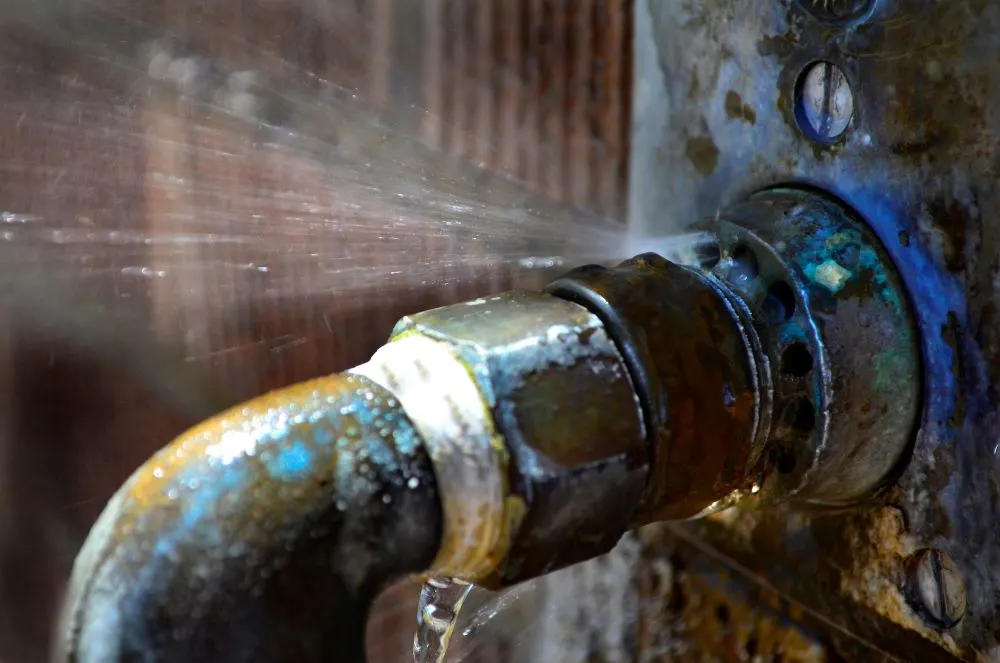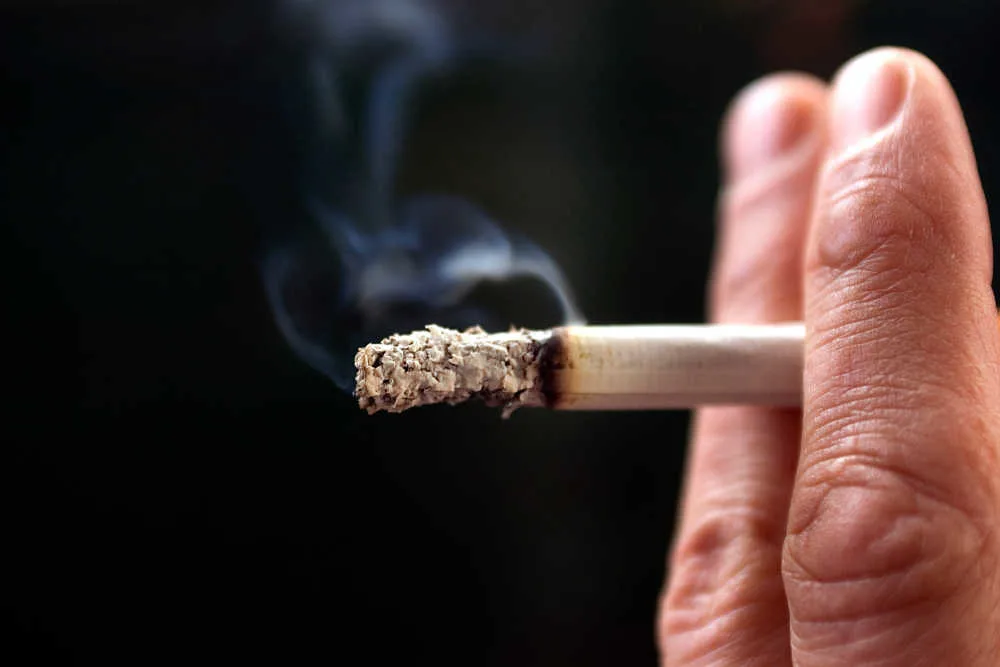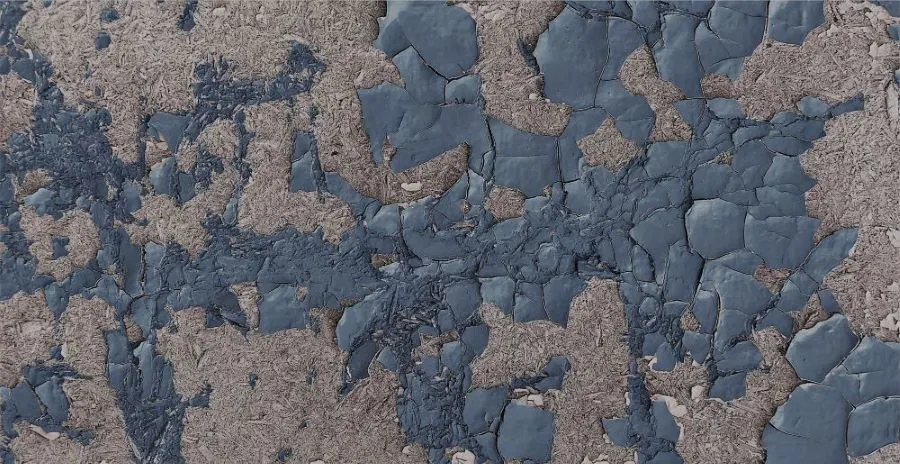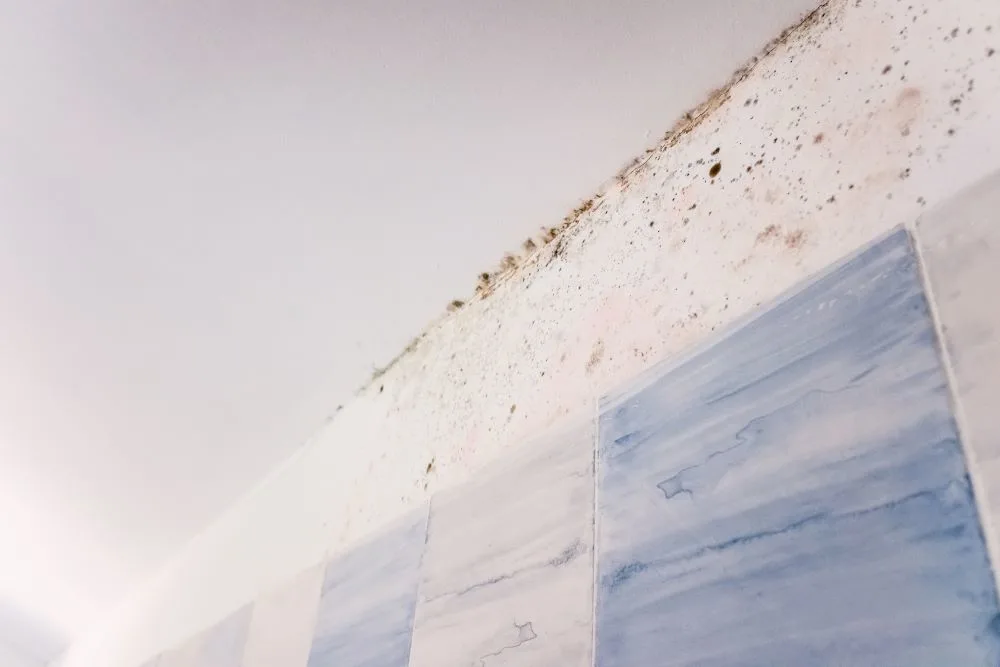When your pristine white bathroom ceiling develops yellow/brown spots, your bathroom immediately looks older and dirtier. There are several possible reasons for the discoloration, most related to water damage.
All of the causes need to be addressed; some sooner than others. The nature of the spots (sticky, oily, dry, or droplets) can help you to identify the problem and, therefore, fix it.

Yellow or brown spots on bathroom ceilings are most likely indications of current or past water damage. Leaking pipes, burst water heaters, poor ventilation, and hard water are the primary sources of this water damage. Mold, cigarette smoke, and oil-based paint can also cause discolored spots on the ceiling.
8 Possible Reasons for Yellow/Brown Ceiling Spots
1. Water Pipes Leaking
Unfortunately, a really common reason for yellow or brown spots on the ceiling is attributed to leaking water pipes. If the pipes are damaged or old, they are more likely to leak water. The discolored spots that appear on your ceiling are the result of this water soaking through the ceiling boards.

If the pipes have leaked for a long time, you might have serious water damage on your ceiling and potentially mold or mildew as well, which is a potential health hazard and a pain to remove from ceilings.
So, once you notice even the smallest brown or yellow spot forming, I’d suggest inspecting it before it gets out of control.
2. Burst Water Heater
In a lot of homes it is really common to store your water heater in your attic as it is a convenient place to store it out of sight while maintaining reasonable accessibility and you can easily connect to plumbing from above.
However, if this water heater bursts (which, unfortunately, is not all that uncommon) then you are in for a bad time.
My dad always says that if a water heater bursts it’s going to do it over a long weekend or in the middle of the night when no one is available to help you fix it.
Having stood with him on at least three separate occasions, all in the middle of the night, watching water leaking through the ceiling, I don’t think he’s being overly paranoid.

The worst part is, however, that being at home and seeing the water leaking through the ceiling means that you are lucky because you can have it attended to as soon as possible, minimizing the damage.
If you are not so fortunate, it can burst while you are away, or it can spread over large areas of the ceiling before soaking through.
When water leaks all over your ceiling, the boards soak it all up and turn yellow/brown. If it doesn’t dry fast enough or is left unattended, it can also cause mold to form.
3. Old Water Damage
Sometimes your yellow/brown stained ceiling might not be a symbol of current water issues in your roof, but rather evidence of previous water damage.
If all has been rectified above the ceiling (in other words, the cause of the initial water damage has been addressed and fixed by you or a previous owner) then it can be a quick fix to simply paint over the stains to hide them.
Alternatively, you can attempt to clean it with a concoction of bleach and water (although you might get an aching back and sore neck).
However, if the root cause from the water damage still persists, cleaning or repainting it will prove to be futile as the stains will simply reappear.
4. Poor Bathroom Ventilation
Another common reason for the dreaded stains or active dripping in your bathroom could be due to the poor ventilation of the room itself.
When you take a shower, have a bath, or brush your teeth, moisture is released into the air in the bathroom. If there is little chance for it to escape, then you will be stuck with excess moisture in your bathroom.
This moisture can cause ceiling stains to form as the water gets absorbed into it; you could also be the victim of mold or mildew growth, which bring along their own consequences.
Water dripping into bathrooms from fans can also be dirty, which means that it will leave brown marks on the ceiling around the fan.
Luckily, it is usually a quick fix by keeping your windows open during and after showers or preferably investing in a bathroom fan to help move the moisture outside.
5. Hard Water (Minerals)
Hard water is very mineral-rich and causes a variety of problems to any household that is unfortunate enough to have it.
If your water is hard, then when you shower and steam is released, or when water leaks out of pipes or your water heater, the minerals will create a dark brown stain on your ceiling once the water has evaporated. These stains are mineral deposits.
If the stains are caused by hard water, then it is imperative that you sort out the issue as soon as possible because the longer the stains sit, the harder they will be get off.
To prevent it from happening again in the future, you can look at installing a water softener system for your house water supply.
6. Indoor Smoking
A non-water-related cause for yellow-stained ceilings is if someone is consistently smoking indoors.
Guests sneak into a bathroom to have a quick smoke break to escape from a busy party downstairs, homeowners head to the bathroom instead of the porch when it’s cold outside, teens, trust the internet when it says that bathroom fans will eliminate all trace of smoking, etc.
Even if you crack a window, smoke rises, so the damage will be done to the ceiling regardless.

Since cigarettes contain tar and nicotine, these toxins create a yellow/brown tinge to the area they stain (ever seen a chronic smoker’s teeth?). Not only are this stains unappealing to the eye, but they also can be accompanied by a nasty stench and serious health hazards.
7. Poor Quality Paint/Insufficient Curing Time
Another possible reason for getting yellow/brown stains on your ceiling that is not necessarily water-related is when you have used poor quality paint to cover your ceiling, or if the shower or bath is used before the paint was allowed sufficient time to dry completely.
The steam from the shower and bath can create blisters on the paint or cause it to peel off, which can allow further moisture to seep through and create stains. It can even result in oil seeping out of the paint and creating drops on your ceiling.

Paint can also become discolored and yellow-ish in areas that are in direct sunlight. If you’re in the process of discovering why things in your bathroom have been stained yellow, you might be interested to know that sunlight can also cause yellow discolorations of your plastic toilet seat.
8. Waterproofing on Attic Side of Ceiling
Waterproofing needs to be laid on the underside of the ceiling (in the room you are trying to waterproof). If it is laid on the other side (the attic side), then all it is doing is trapping moisture in the construction. This has many downsides, one of which is the formation of yellow/brown stains on the ceiling.
If you have yellow or brown spots on your ceiling as a result of any of the above reasons, then you likely also have the spots on your walls. You can find a few additional causes of yellow marks on walls and the solutions to these problems in Why Do Bathroom Walls Sweat Yellow/Brown (How to stop it).
Yellow/Brown Stain on Ceiling Not Wet
While we can definitely conclude that water damage causes yellow/brown stains on the ceiling, these stains might not always symbolize a current water leak or issue.
When you have yellow or brown stains on your ceiling, but when you touch them they are just as dry as the rest of the ceiling, then these stains are most probably an indication of older water damage.
Perhaps when you bought the house, the tiles of the roof were old and had holes, allowing rainwater to seep through and accumulate on the ceiling.
Since then, you have replaced them to ensure no water seeps through, keeping your home dry. However, the yellow/brown stains are still there like when you moved in.
As long as you have treated the root cause of the initial water damage, then you can simply clean the stains or paint over it to give your bathroom a fresh new look.
In order to prevent such stains from occurring again, make sure that the bathroom is well-ventilated and that all water sources are in good working order (such as pipes, water heater and even the HVAC) so that you don’t have moisture issues in the future.
Oily Yellow/Brown Spots on Bathroom Ceiling
If you notice that the yellow/brown spots are oily to the touch, then you are probably finding these stains above the shower or bathtub as these are the areas that will release the most moisture.
If you painted your bathroom ceiling using oil-based paint and perhaps failed to mix the paint properly before use, then you will notice these kinds of stains more often.
This is because oil-based stains are water-repellent, so when in contact with moisture (such as the steam after a hot shower) the oil basically becomes separate from the water, making an oily appearance.
Luckily, these stains can be cleaned off with a solution of bleach and water. However, they will reappear if you don’t open a window during hot showers or even repaint the ceiling effectively.
Yellow/Brown Droplets on Ceiling
Sometimes the yellow/brown stain is accompanied by water droplets of the same color. This is a huge red flag as it is an indication of some kind of ongoing water leakage above the ceiling, which is dripping through the wood.
Alternatively, it could also be due to high humidity levels, which is not uncommon in bathrooms especially those with a lack of ventilation.

Solving this problem is a little trickier as simply washing it away will do nothing but create a fresh surface for the droplets to reappear on again. You need to find the source of the humidity or water leakage.
If it is humidity, you will need to sort out your ventilation and inspect your waterproofing.
You can help prevent this situation by making sure your bathroom is dry. Install an exhaust fan (amazon link), invest in a dehumidifier (amazon link), keep your window open at all times to reduce the moisture levels, etc.
Sticky Yellow/Brown Spots on Ceiling
If you are getting yellow or brown spots on your ceiling that are quite sticky, possibly even resembling that of cola soda, then your bathroom is the victim of high humidity.
Depending on the paint that is covering your ceiling, the excess moisture will cause some of the components of the paint to leach to the surface, appearing in a yellowish/brown color.
These stains can be washed away with your average cleaning detergent and water (you may have to repeat the scrub and rinse process a couple of times before the stain has completely disappeared), but they will likely reappear unless you make some effort to reduce the humidity levels in your bathroom.
Sources
https://hdecorideas.com/how-to-fix-yellow-drips-on-walls-and-ceilings/
https://www.everydaycleaningideas.com/how-to-remove-yellow-water-stains-from-ceiling/
https://www.labourmatters.com/brown-spots-on-ceiling/#What_causes_brown_spots_on_ceiling
https://forums.whirlpool.net.au/archive/3xk78mw9
https://intekclean.com/2018/03/09/how-to-clean-cigarette-smoke-off-walls/
https://www.schedulefred.com/blog/painting-oil-based-paints/


